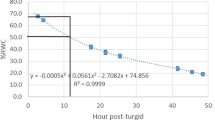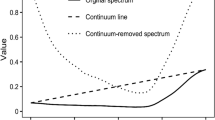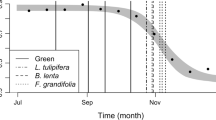Abstract
Variations in water absorption across lettuce leaves (Latuca sativa L. var. longifolia) were quantified from hyperspectral imagery acquired in the laboratory using selected spectral indices, specifically, the Moisture Stress Index (MSI), the Normalised Difference Water Index (NDWI) and the intensity of specific water absorptions at 970 nm (IA970), 1170 nm (IA1170) and 1775 nm (IA1775). Absorption was separately quantified for the midrib, the green parts of the leaves and for whole leaves. Indices were non-linearly related to water content expressed per weight of wet plant material (g g−1) but linearly to water content per unit area of leaf (g cm−2). Indices were weakly correlated with water content in the stem but strongly correlated with water in the green parts of leaves and in whole leaves. Water content in whole leaves was significantly underestimated (P < 0.01) when it was predicted from a model developed for the green parts of leaves, indicating that water content must be derived from the same leaf component used to derive the predictive model. Some indices (NDWI, MSI, IA1170) highlighted intricate reticulated patterns of water absorption across the leaves but these were poorly defined by other indices (IA970, IA1775). Indices extracted from the leaf along transverse and longitudinal transects were qualitatively similar but quantitative analysis indicated that they were significantly different (P < 0.05). The principal contribution of this study is that it highlights the implications of quantifying leaf water content from hyperspectral imagery acquired at spatial resolutions great enough to resolve individual leaf components.








Similar content being viewed by others
References
Asner, G. P., Carlson, K. M., & Martin, R. E. (2005). Substrate age and precipitation effects on Hawaiian forest canopies from spaceborne imaging spectroscopy. Remote Sensing of Environment, 98(4), 457–467. https://doi.org/10.1016/j.rse.2005.08.010.
Ballester, C., Zarco-Tejada, P. J., Nicolás, E., Alarcón, J. J., Fereres, E., Intrigliolo, D. S., et al. (2017). Evaluating the performance of xanthophyll, chlorophyll and structure-sensitive spectral indices to detect water stress in five fruit tree species. Precision Agriculture. https://doi.org/10.1007/s11119-017-9512-y.
Behmann, J., Steinrücken, J., & Plümer, L. (2014). Detection of early plant stress responses in hyperspectral images. ISPRS Journal of Photogrammetry and Remote Sensing, 93, 98–111. https://doi.org/10.1016/j.isprsjprs.2014.03.016.
Ceccato, P., Flasse, S., Tarantola, S., Jacquemoud, S., & Grégoire, J.-M. (2001). Detecting vegetation leaf water content using reflectance in the optical domain. Remote Sensing of Environment, 77(1), 22–33. https://doi.org/10.1016/S0034-4257(01)00191-2.
Cilia, C., Panigada, C., Rossini, M., Meroni, M., Busetto, L., Amaducci, S., et al. (2014). Nitrogen status assessment for variable rate fertilization in maize through hyperspectral imagery. Remote Sensing, 6(7), 6549.
Clark, R. N., & Roush, T. L. (1984). Reflectance spectroscopy: Quantitative analysis techniques for remote sensing applications. Journal of Geophysical Research, 89(B7), 6329–6340.
Danson, F. M., Steven, M. D., Malthus, T. J., & Clark, J. A. (1992). High-spectral resolution data for determining leaf water content. International Journal of Remote Sensing, 13(3), 461–470. https://doi.org/10.1080/01431169208904049.
Dawson, T. P., Curran, P. J., North, R. J., & Plummer, S. E. (1998). The propagation of foliar biochemical absorption features in forest canopy reflectance: A theoretical analysis. Remote Sensing of Environment, 67, 147–159.
Ding, C., Liu, X., Huang, F., Li, Y., & Zou, X. (2017). Onset of drying and dormancy in relation to water dynamics of semi-arid grasslands from MODIS NDWI. Agricultural and Forest Meteorology, 234, 22–30. https://doi.org/10.1016/j.agrformet.2016.12.006.
Feng, W., Qi, S., Heng, Y., Zhou, Y., Wu, Y., Liu, W., et al. (2017). Canopy vegetation indices from in situ hyperspectral data to assess plant water status of winter wheat under powdery mildew stress. Frontiers in Plant Science. https://doi.org/10.3389/fpls.2017.01219.
Gao, B. C. (1996). NDWI—A normalized difference water index for remote sensing of vegetation liguid water from space. Remote Sensing of Environment, 58, 257–266.
Hunt, E. R., Daughtry, C. S. T., Qu, J. J., Wang, L., & Hao, X. J. (2011) Comparison of hyperspectral retrievals with vegetation water indices for leaf and canopy water content. In Remote sensing and modeling of ecosystems for sustainability VIII SPIE optical engineering + applications, San Diego, CA, 2011 (Vol. 8156, pp. 815606). SPIE
Hunt, E. R., & Rock, B. N. (1989). Detection of changes in leaf water content using near- and middle-infrared reflectances. Remote Sensing of Environment, 30(1), 43–54. https://doi.org/10.1016/0034-4257(89)90046-1.
Kim, D. M., Zhang, H., Zhou, H., Du, T., Wu, Q., Mockler, T. C., et al. (2015). Highly sensitive image-derived indices of water-stressed plants using hyperspectral imaging in SWIR and histogram analysis. Scientific Reports, 5, 15919. https://doi.org/10.1038/srep15919.
Kruse, F. A., Lefkoff, A. B., Boardman, J. B., Heidebrecht, K. B., Shapiro, A. T., Barloon, P. J., et al. (1993). The spectral image processing system (SIPS)—interactive visualization and analysis of imaging spectrometer data. Remote Sensing of Environment, 44, 145–163.
Liu, J., Miller, J. R., Pattey, E., Haboudane, D., Strachan, I. B., & Hinther, M. (2004) Monitoring crop biomass accumulation using multi-temporal hyperspectral remote sensing data. In IGARSS 2004. 2004 IEEE international geoscience and remote sensing symposium, September 20–24, 2004 (Vol. 3, pp. 1637–1640 vol.1633). https://doi.org/10.1109/igarss.2004.1370643.
Mahlein, A. K., Steiner, U., Dehne, H. W., & Oerke, E. C. (2010). Spectral signatures of sugar beet leaves for the detection and differentiation of diseases. Precision Agriculture. https://doi.org/10.1007/s11119-010-9180-7.
Murphy, R. J. (2015). Evaluating simple proxy measures for estimating the depth of the ~ 1900 nm water absorption feature from hyperspectral data acquired under natural illumination. Remote Sensing of Environment, 166, 22–33.
Murphy, R. J., Tolhurst, T. J., Chapman, D. J., & Underwood, A. J. (2005). Remote-sensing of benthic chlorophyll: Should ground-truth data be expressed in units of area or mass? Journal of Experimental Marine Biology and Ecology, 316, 69–77.
Ollinger, S. V. (2011). Sources of variability in canopy reflectance and the convergent properties of plants. New Phytologist, 189(2), 375–394. https://doi.org/10.1111/j.1469-8137.2010.03536.x.
Pandey, P., Ge, Y., Stoerger, V., & Schnable, J. C. (2017). High throughput in vivo analysis of plant leaf chemical properties using hyperspectral imaging. Frontiers in Plant Science. https://doi.org/10.3389/fpls.2017.01348.
Penuelas, J., Filella, I., Biel, C., Serrano, L., & Save, R. (1993). The reflectance at the 950-970 nm region as an indicator of plant water status. International Journal of Remote Sensing, 14(10), 1887–1905.
Penuelas, J., Pinol, J., Ogaya, R., & Filella, I. (1997). Estimation of plant water concentration by the Reflectance Water Index WI (R900/R970). International Journal of Remote Sensing, 18(13), 2869–2875.
Rollin, E. M., & Milton, E. J. (1998). Processing of high spectral resolution reflectance data for the retrieval of canopy water content information. Remote Sensing of Environment, 65, 86–92.
Sankaran, S., Khot, L. R., Espinoza, C. Z., Jarolmasjed, S., Sathuvalli, V. R., Vandemark, G. J., et al. (2015). Low-altitude, high-resolution aerial imaging systems for row and field crop phenotyping: A review. European Journal of Agronomy, 70, 112–123. https://doi.org/10.1016/j.eja.2015.07.004.
Sankaran, S., Mishra, A., Ehsani, R., & Davis, C. (2010). A review of advanced techniques for detecting plant diseases. Computers and Electronics in Agriculture, 72(1), 1–13. https://doi.org/10.1016/j.compag.2010.02.007.
Serrano, L., Ustin, S., Roberts, D. A., Gamon, J. A., & Penuelas, J. (2000). Deriving water content of Chaparral vegetation from AVIRIS data. Remote Sensing of Environment, 74, 570–581.
Sims, D. A., & Gamon, J. A. (2003). Estimation of vegetation water content and photosynthetic tissue area from spectral reflectance: A comparison of indices based on liquid water and chlorophyll absorption features. Remote Sensing of Environment, 84, 526–537.
Steidle Neto, J. A., Lopes, D. D., & Borges Júnior, C. J. (2017). Assessment of photosynthetic pigment and water contents in intact sunflower plants from spectral indices. Agriculture. https://doi.org/10.3390/agriculture7020008.
Suárez, L., Zarco-Tejada, P. J., González-Dugo, V., Berni, J. A. J., Sagardoy, R., Morales, F., et al. (2010). Detecting water stress effects on fruit quality in orchards with time-series PRI airborne imagery. Remote Sensing of Environment, 114(2), 286–298. https://doi.org/10.1016/j.rse.2009.09.006.
Takala, T. L. H., & Mottus, M. (2016). Spatial variation of canopy PRI with shadow fraction caused by leaf-level irradiation conditions. Remote Sensing of Environment, 182, 99–112. https://doi.org/10.1016/j.rse.2016.04.028.
Tian, Q., Tong, Q., Pu, R., Guo, X., & Zhao, C. (2001). Spectroscopic determination of wheat water status using 1650-1850 nm spectral absorption features. International Journal of Remote Sensing, 22(12), 2329–2338. https://doi.org/10.1080/01431160118199.
Underwood, J., Wendel, A., Schofield, B., McMurray, L., & Kimber, R. (2017). Efficient in-field plant phenomics for row-crops with an autonomous ground vehicle. Journal of Field Robotics, 34(6), 1061–1083. https://doi.org/10.1002/rob.21728.
Vigneau, N., Ecarnot, M., Rabatel, G., & Roumet, P. (2011). Potential of field hyperspectral imaging as a non destructive method to assess leaf nitrogen content in Wheat. Field Crops Research, 122(1), 25–31. https://doi.org/10.1016/j.fcr.2011.02.003.
Wang, C., Nie, S., Xi, X., Luo, S., & Sun, X. (2017). Estimating the biomass of maize with hyperspectral and LiDAR data. Remote Sensing, 9(1), 11.
Wang, L. L., Hunt, E. R., Qu, J. J., Hao, X. J., & Daughtry, C. S. T. (2013). Remote sensing of fuel moisture content from ratios of narrow-band vegetation water and dry-matter indices. Remote Sensing of Environment, 129, 103–110. https://doi.org/10.1016/j.rse.2012.10.027.
Wang, X., Zhao, C., Guo, N., Li, Y., Jian, S., & Yu, K. (2015). Determining the canopy water stress for spring wheat using canopy hyperspectral reflectance data in loess plateau semiarid regions. Spectroscopy Letters, 48(7), 492–498. https://doi.org/10.1080/00387010.2014.909495.
Wendel, A., & Underwood, J. (2017). Illumination compensation in ground based hyperspectral imaging. ISPRS Journal of Photogrammetry and Remote Sensing, 129, 162–178.
Xiao, Y. F., Zhao, W. J., Zhou, D. M., & Gong, H. L. (2014). Sensitivity analysis of vegetation reflectance to biochemical and biophysical variables at leaf, canopy, and regional scales. IEEE Transactions on Geoscience and Remote Sensing, 52(7), 4014–4024. https://doi.org/10.1109/tgrs.2013.2278838.
Yang, C., & Everitt, J. H. (2012). Using spectral distance, spectral angle and plant abundance derived from hyperspectral imagery to characterize crop yield variation. Precision Agriculture, 13(1), 62–75. https://doi.org/10.1007/s11119-011-9248-z.
Yang, C., Everitt, J. H., Bradford, J. M., & Murden, D. (2004). Airborne hyperspectral imagery and yield monitor data for mapping cotton yield variability. Precision Agriculture, 5(5), 445–461. https://doi.org/10.1007/s11119-004-5319-8.
Yilmaz, M. T., Hunt, E. R., & Jackson, T. J. (2008). Remote sensing of vegetation water content from equivalent water thickness using satellite imagery. Remote Sensing of Environment, 112, 2514–2522.
Yu, K.-Q., Zhao, Y.-R., Li, X.-L., Shao, Y.-N., Liu, F., & He, Y. (2014). Hyperspectral imaging for mapping of total nitrogen spatial distribution in pepper plant. PLoS ONE, 9(12), e116205. https://doi.org/10.1371/journal.pone.0116205.
Zarco-Tejada, P. J., Berjón, A., López-Lozano, R., Miller, J. R., Martín, P., Cachorro, V., et al. (2005). Assessing vineyard condition with hyperspectral indices: Leaf and canopy reflectance simulation in a row-structured discontinuous canopy. Remote Sensing of Environment, 99(3), 271–287. https://doi.org/10.1016/j.rse.2005.09.002.
Zarco-Tejada, P. J., Catalina, A., González, M. R., & Martín, P. (2013a). Relationships between net photosynthesis and steady-state chlorophyll fluorescence retrieved from airborne hyperspectral imagery. Remote Sensing of Environment, 136, 247–258. https://doi.org/10.1016/j.rse.2013.05.011.
Zarco-Tejada, P. J., González-Dugo, V., & Berni, J. A. J. (2012). Fluorescence, temperature and narrow-band indices acquired from a UAV platform for water stress detection using a micro-hyperspectral imager and a thermal camera. Remote Sensing of Environment, 117, 322–337. https://doi.org/10.1016/j.rse.2011.10.007.
Zarco-Tejada, P. J., Guillén-Climent, M. L., Hernández-Clemente, R., Catalina, A., González, M. R., & Martín, P. (2013b). Estimating leaf carotenoid content in vineyards using high resolution hyperspectral imagery acquired from an unmanned aerial vehicle (UAV). Agricultural and Forest Meteorology, 171–172, 281–294. https://doi.org/10.1016/j.agrformet.2012.12.013.
Acknowledgements
The authors thank Asher Bender, David Spray and Steven Potiris for their help in the field. The authors gratefully acknowledge funding from the Australian Centre for Field Robotics for funding this research.
Author information
Authors and Affiliations
Corresponding author
Rights and permissions
About this article
Cite this article
Murphy, R.J., Whelan, B., Chlingaryan, A. et al. Quantifying leaf-scale variations in water absorption in lettuce from hyperspectral imagery: a laboratory study with implications for measuring leaf water content in the context of precision agriculture. Precision Agric 20, 767–787 (2019). https://doi.org/10.1007/s11119-018-9610-5
Published:
Issue Date:
DOI: https://doi.org/10.1007/s11119-018-9610-5




